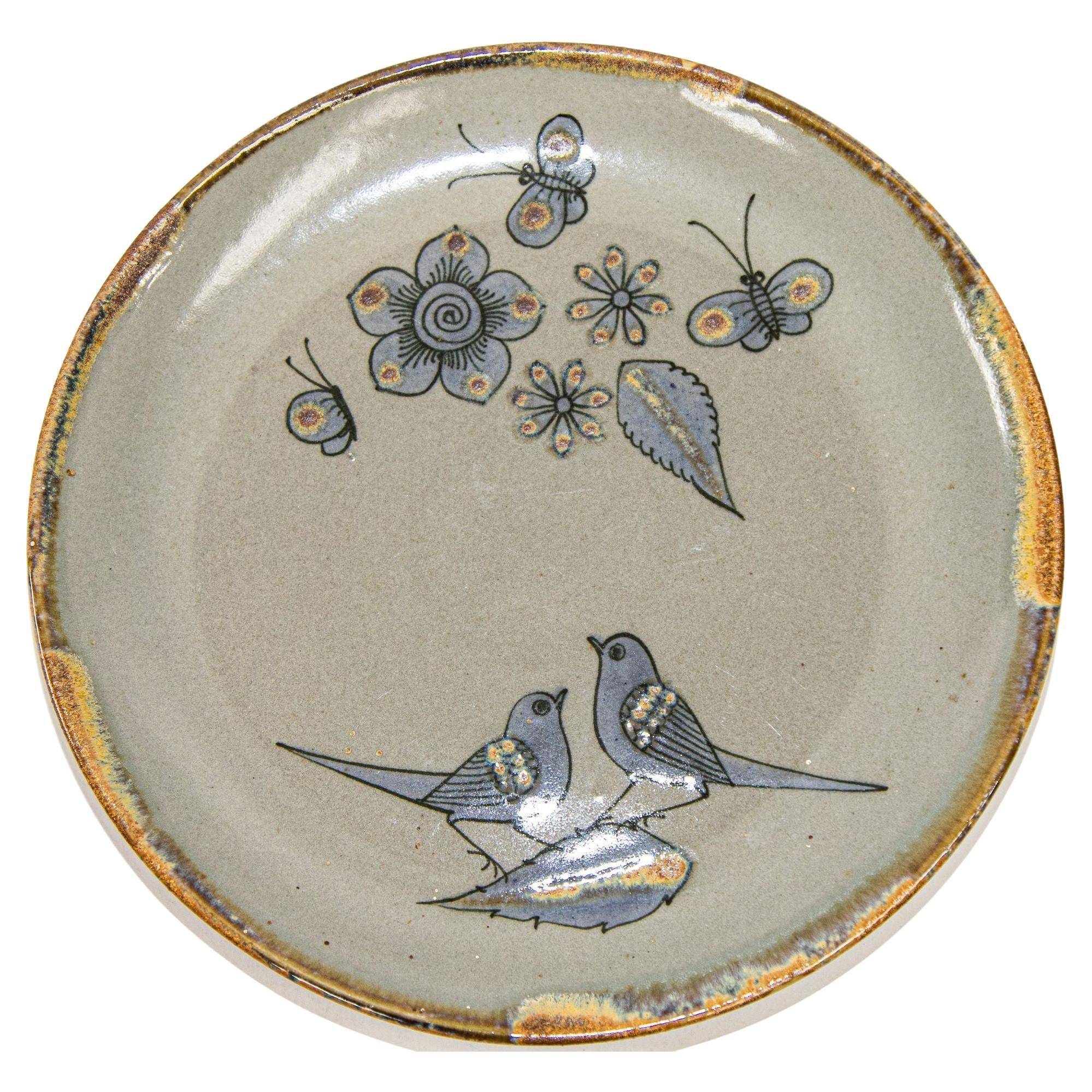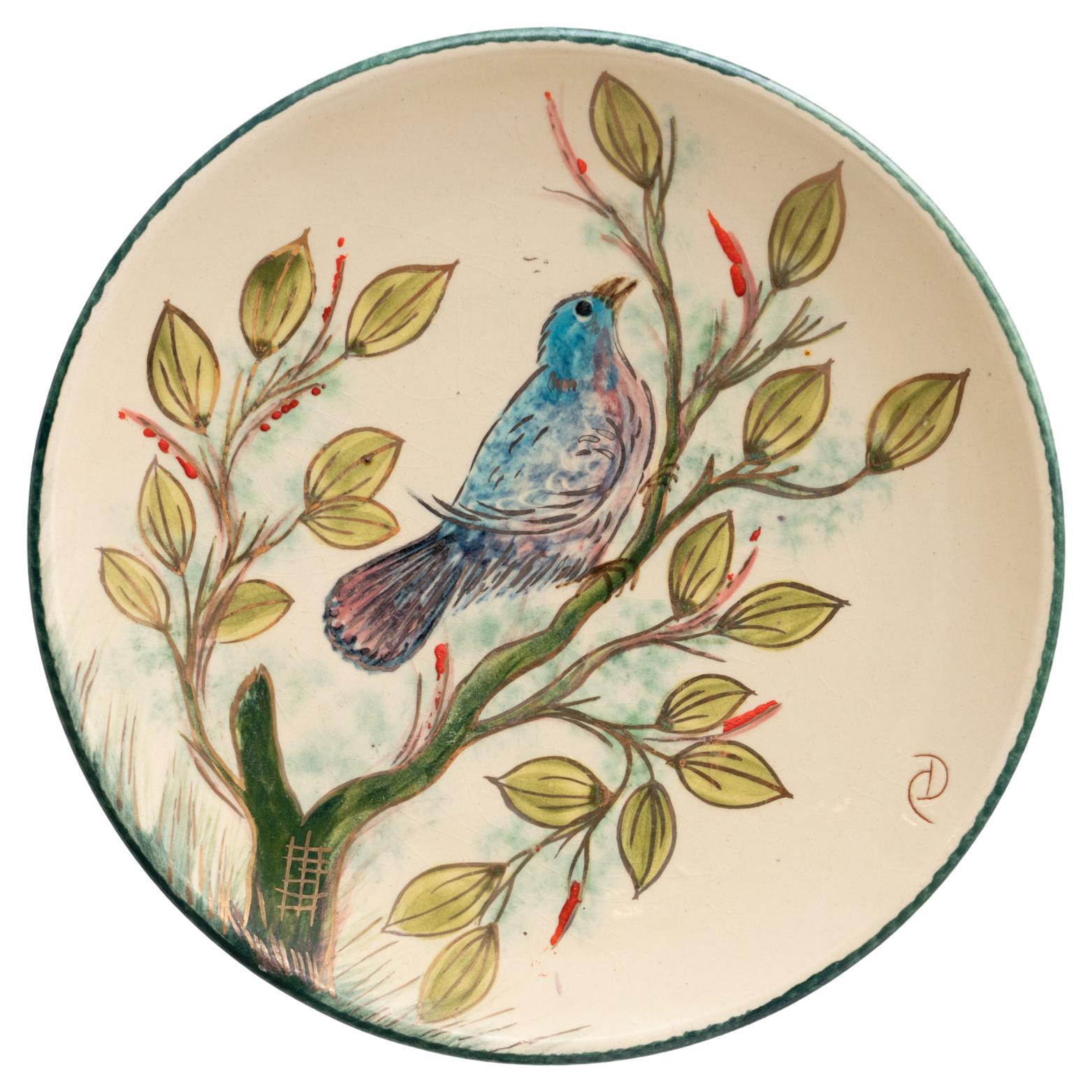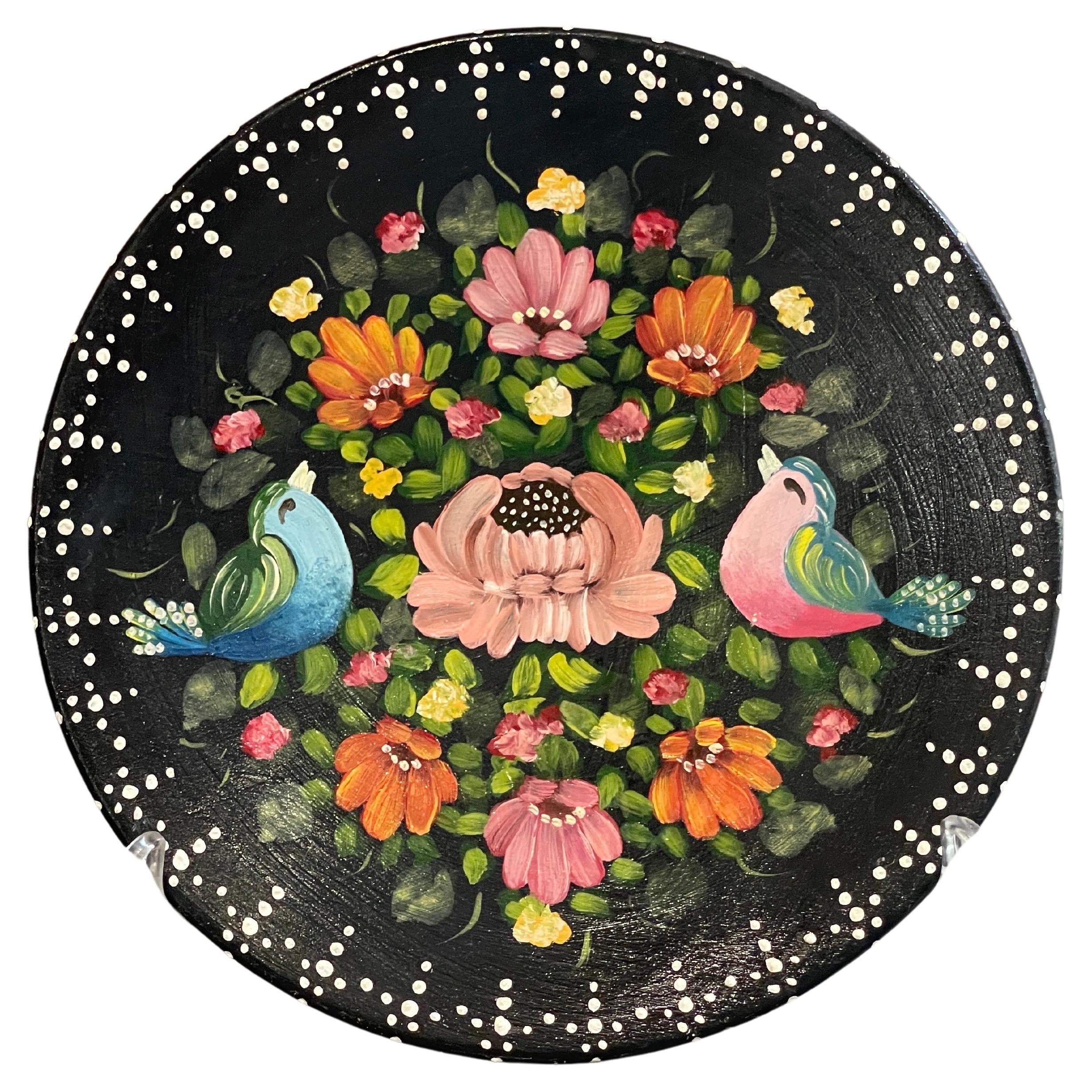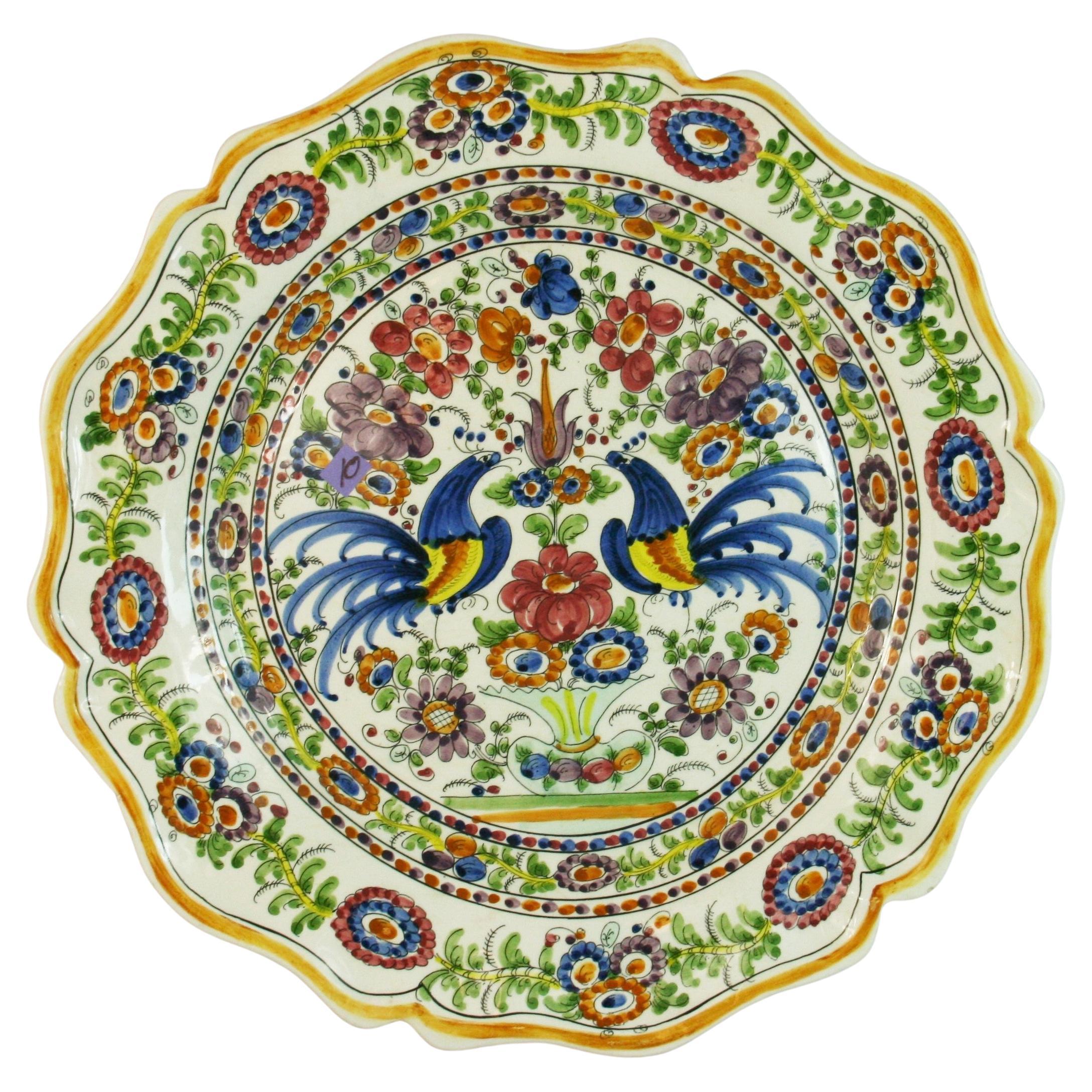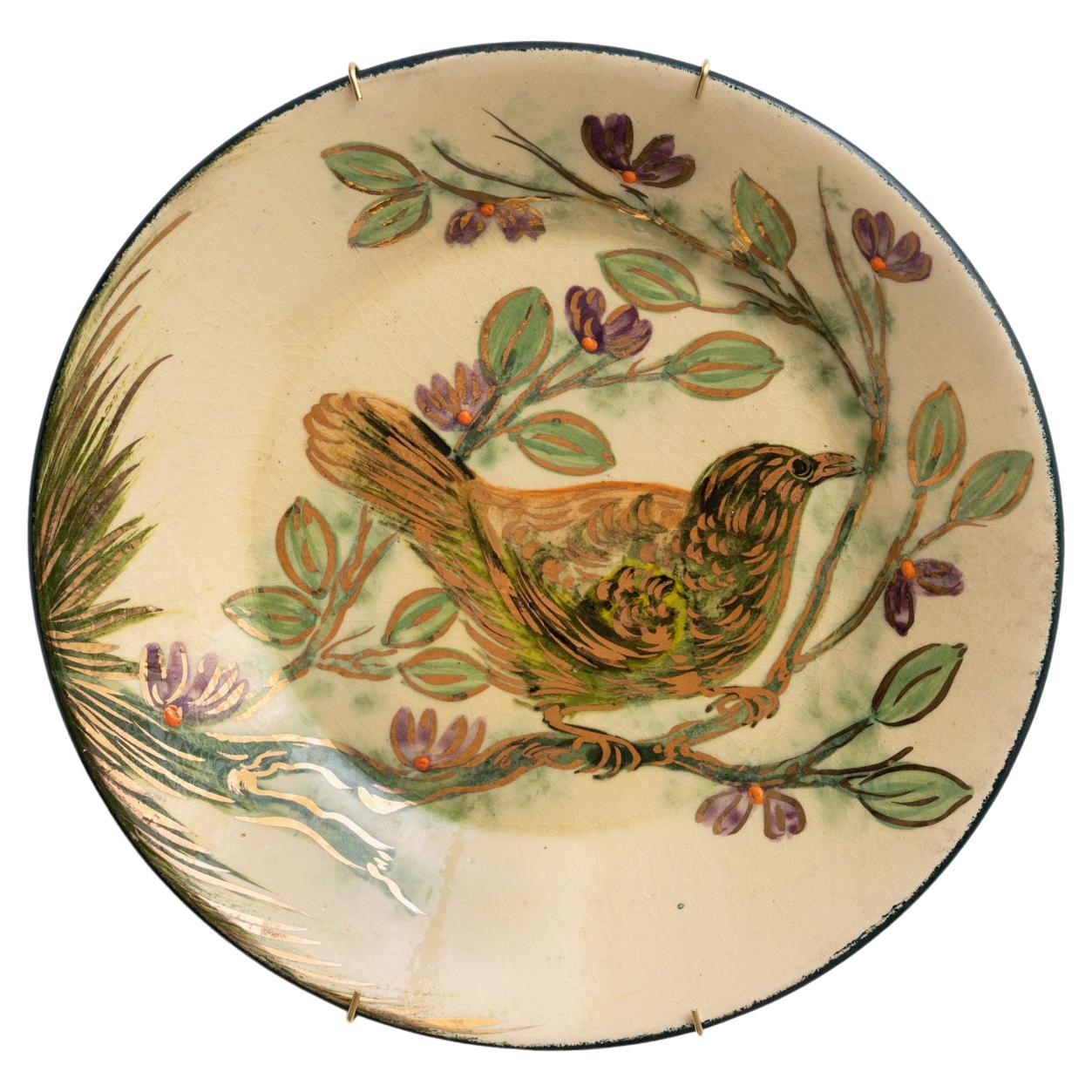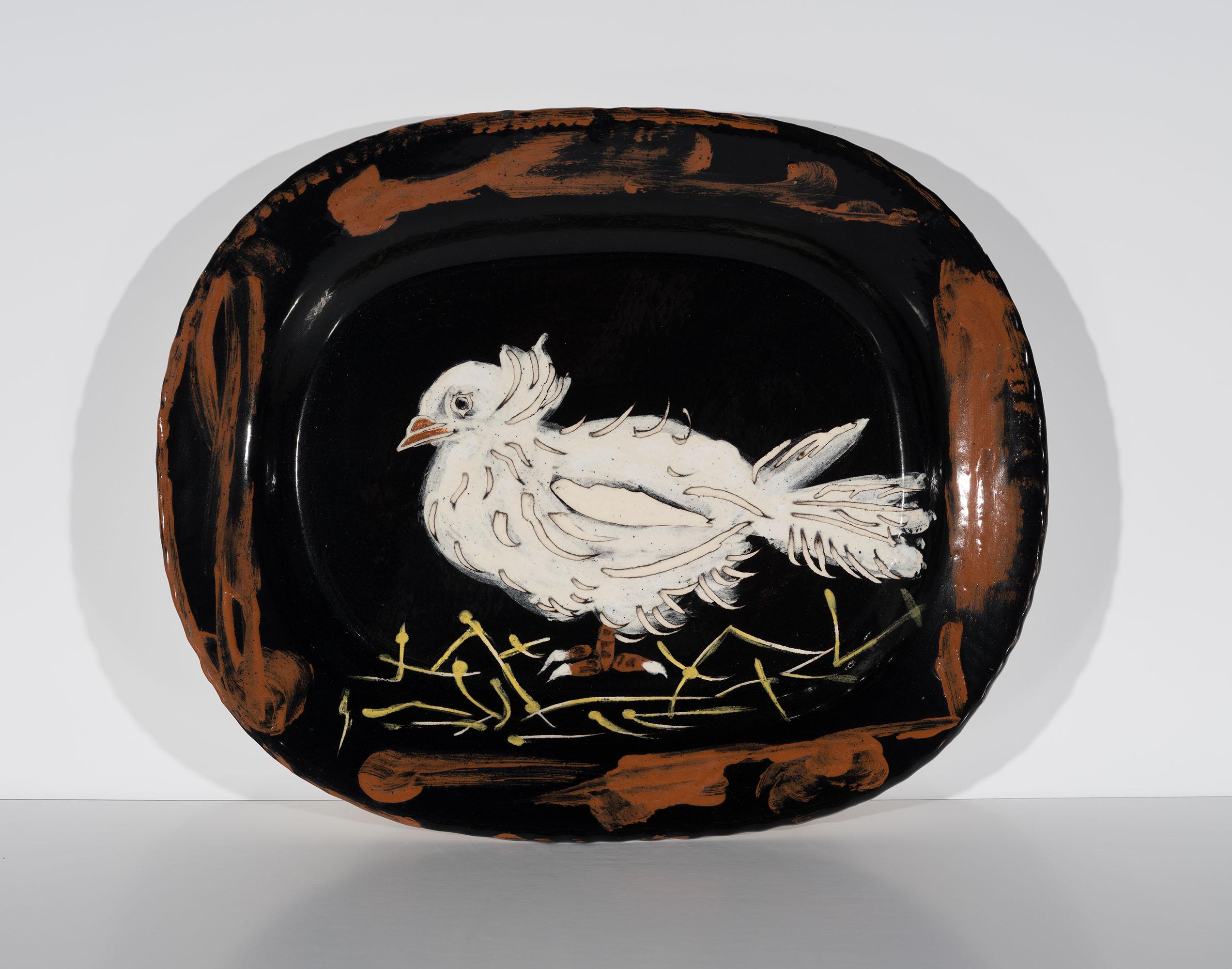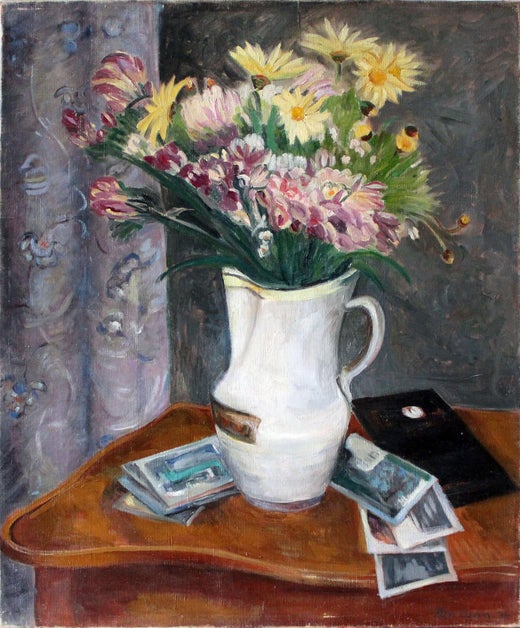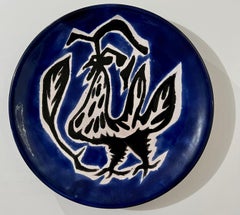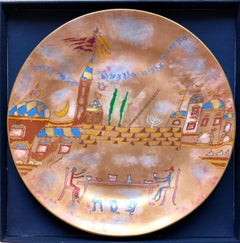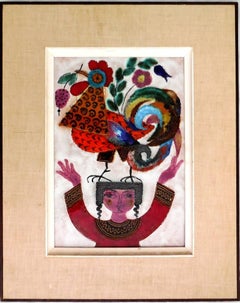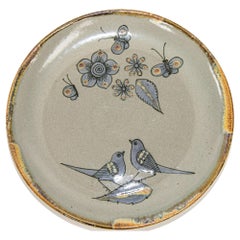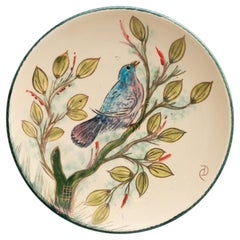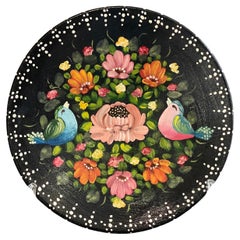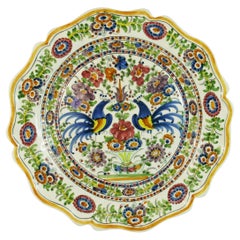Items Similar to Dove of Peace Limoges plate
Want more images or videos?
Request additional images or videos from the seller
1 of 5
Ben BennDove of Peace Limoges plate
$500
£383.98
€440.03
CA$703.88
A$788.50
CHF 410.12
MX$9,618.04
NOK 5,221.33
SEK 4,923.34
DKK 3,284.30
About the Item
Born in Bialystok, Poland. His full name is Benzion Rabinowicz. His grandfather was a Rabbi and his father was an architect. Benn was a Jewish-Polish painter and graphic artist. After studying at the Academy of Arts in Warsaw he made his debut in 1927 with his first solo exhibition. During this time he designed the typography for various collections of Yiddish poetry. After being very active in the 1920's and 30's in the Polish theater scene as well as being the founder of the modernist group "3F", he went to Paris to study with Fernand Leger. After the German occupation of France in 1940 he went into hiding. After being denounced he was arrested by the Gestapo and sent to a concentration camp but miraculously survived the war. He returned to Paris and in the post-war years he developed his own style of metaphysical painting techniques and surrealism. Later in his life Benn also was active in book design and contributed illustrations for various books of the Bible and for The Song of Songs. During the period after the war, Benn dealt with biblical themes, mostly in small formats. This interest in biblical themes was very common among Jewish artists that survived the war and the holocaust. The holocaust caused many Jewish people question the existence of god, some became atheists, and some became stronger believers. One of his most notable works in this theme is the 126 illustrations of psalms that were presented in the Museum of Modern Art in Paris, Museum of Lyon and many other places.
Expositions marquantes ———————
Galerie Katia Granoff
Galerie d’art Matignon – Galerie de Marignan
Galerie Charpentier (actuellement Sotheby’s)
Galerie Gaveau – Ville de Montréal
Musée d’art moderne de Lyon
Musée d’art moderne à Paris
Musée du Petit Palais à Genève
Orangerie du Luxembourg à Paris
Musée Carnavalet – Paris
Villes de Tokyo – Kyoto – Osaka
Hommage au Grand Palais – Paris
U.N.E.S.C.O. – Paris
- Creator:Ben Benn (1905 - 1989, Polish)
- Dimensions:Height: 9 in (22.86 cm)Width: 9 in (22.86 cm)Depth: 1 in (2.54 cm)
- Medium:
- Movement & Style:
- Period:
- Condition:
- Gallery Location:Surfside, FL
- Reference Number:1stDibs: LU38210565772
Ben Benn
Ben Benn’s prominence in the art world over six decades was reaffirmed at a 90th birthday show at the Hirshhorn Museum in Washington, D.C. in 1974. Benn had many solo exhibitions during his lifetime, including one at the Jewish Museum in 1965. His works are in many museums, including the Metropolitan Museum of Art, Whitney and Hirshhorn Museum.
About the Seller
4.9
Platinum Seller
Premium sellers with a 4.7+ rating and 24-hour response times
Established in 1995
1stDibs seller since 2014
1,788 sales on 1stDibs
Typical response time: <1 hour
- ShippingRetrieving quote...Shipping from: Surfside, FL
- Return Policy
Authenticity Guarantee
In the unlikely event there’s an issue with an item’s authenticity, contact us within 1 year for a full refund. DetailsMoney-Back Guarantee
If your item is not as described, is damaged in transit, or does not arrive, contact us within 7 days for a full refund. Details24-Hour Cancellation
You have a 24-hour grace period in which to reconsider your purchase, with no questions asked.Vetted Professional Sellers
Our world-class sellers must adhere to strict standards for service and quality, maintaining the integrity of our listings.Price-Match Guarantee
If you find that a seller listed the same item for a lower price elsewhere, we’ll match it.Trusted Global Delivery
Our best-in-class carrier network provides specialized shipping options worldwide, including custom delivery.More From This Seller
View AllVintage French Modernist Jean Lurcat Glazed Ceramic Art Plate Sant-Vicens France
By Jean Lurçat
Located in Surfside, FL
Vintage Jean Lurcat glazed fired enamel wall plaque ceramic plate limited edition hand inscribed faience Ceramique Saint Vicens charger. It depicts a h...
Category
Mid-20th Century Modern More Art
Materials
Ceramic, Glaze
Post Modern Italian Passover Seder Plate Richard Ginori Art Porcelain Judaica
Located in Surfside, FL
Johanan Vitta, painter, born 1941, Jerusalem. Lives in Italy.
Education Firenze, Florence, Italy
He designed the famous La Sinagoga di Firenze poster. The poster features a painterly synagogue it was done for the “Comunita Israelitica"
He has also designed Judaic ritual objects including a menorah that is in a famous museum collection. Arman, Elio Carmi, Eugenio Carmi, Lucio Del Pezzo, Guy De Rougemont, Maurizio Galimberti, David Gerstein, Claude Lalanne, Marino Marinelli, Mimmo Paladino, Arnaldo Pomodoro, Tobia Rava...
Category
1980s Post-Modern Abstract Sculptures
Materials
Porcelain
Rare European 19C Judaica Havdalah Hebrew Plate
Located in Surfside, FL
Here is a rare late 19th Century-early 20th Century painted and stenciled Jewish plate with a Yiddish greeting. A rare piece of Jewish Porcelain from the...
Category
Late 19th Century Folk Art More Art
Materials
Porcelain
Girl & Rooster Enamel Glazed Ceramic Plaque Israeli Artist Awret Naive Folk Art
By Irene Awret
Located in Surfside, FL
This is a rare ceramic plaque painted with enamel glaze by famed Israeli German artist Irene Awret is signed Awret Safed on the verso. the actual glazed ceramic is 10X15 inches.
Irène Awret was born to a Jewish family in Berlin called Spicker, the youngest of three children. Her mother died in 1927, when Irène was six years old. In 1937 she was forced to stop high school, due to the Nazi race laws. Because she could not continue her regular studies, her father sent her to study drawing, painting and art restoration with a Jewish painter. Among his students were a large number of German Jews who knew they would have to leave Germany within a short time and would require a profession to enable them to support themselves.
When the situation grew worse, following the Kristallnacht (the first major attack on German and Austrian Jews in November 1938), her uncle decided to move to Belgium. In 1939 the situation became even worse - her father was fired from his job and the family were forced to leave their home. As a result, Awret's father tried to send her and her sister to Belgium, with the help of smugglers. The first smuggler proved to be a double agent and they were sent back from Aachen to Berlin. Two weeks later they made a second, successful, attempt to sneak across the border.
Awret worked for a Dutch Jewish family as a maid. As she had her room and board there, she was able to save enough money to study art part-time at Brussels' Académie Royal des Beaux-Arts. A few months later Awret's father joined her and her financial situation became easier. She left her job and studied full-time, helping support herself with restoration work when it was available and by painting portraits to order.
Later, Awret found a hiding place on a farm in Waterloo with a Jewish family who were connected with the underground. In January 1943 she had to return to Brussels, living with a false identity card which stated she was a married woman with two children. Awret succeeded in renting an attic without informing the police where she was - she told her landlady that she had been forced to flee her husband because he beat her. While there, she supported herself by restoring wooden sculptures.
A Jewish informer gave her up to the Gestapo, accompanying the two Gestapo men who arrested her. Awret was able to take a bag containing food and drawing materials. She was detained in the Gestapo cellars in Brussels where she drew. Because there was nothing there to draw, she sketched her own hand (view this work). Awret was interrogated in order to reveal the hiding place of her father who was still in Brussels. The National Socialist regime was determined to persecute him, even though he had fought for Germany in World War I and been permanently disabled. They stepped up their torture and brought Awret before Hartmann, the head of the Gestapo in Brussels. When Hartmann saw her block of drawings, he asked her where she had studied art and halted the interrogation.
Awret was placed in a narrow cell and then transferred to Malines camp, which the Belgian's called Mechelen. Malines was a transit camp to Auschwitz, regularly sending 2000 people at a time. Although she arrived just before Transport No. 20, Irène Awret avoided being included. Instead she was put to work in the leather workshop, decorating broaches. While she was there, Hartmann visited the camp and spotted her: "I could have discovered where your father is hiding," he told her. When her artistic talents became known, she was transferred to the Mahlerstube (artist's workshop) where she worked producing graphics for the Germans until the end of the war. When Carol (Karel) Deutsch (whose works are now on view at Yad Vashem) was sent from Mechelen to his death with his wife, he left young Irene his paintbox. Irene also recalls seeing the great painter Felix Nussbaum and his wife being pushed into a boxcar bound for the gas, and tells of the aftermath of the famous 20th Train incident, when a young Jewish doctor armed only with a pistol and helped by two unarmed friends with a lantern ambushed one of Mechelen's Auschwitz-bound trains carrying 1,618 Jews, most of whom had fled Eastern Europe for Belgium.
Awret's job enabled her to paint and draw - mainly in pencil, but also in watercolors and oils. In the artists' workshop she met a Jewish refugee from Poland - Azriel Awret...
Category
1950s Expressionist Figurative Paintings
Materials
Enamel
Girl & Plants Enamel Glazed Ceramic Plaque Israeli Artist Awret Naive Folk Art
By Irene Awret
Located in Surfside, FL
This is a rare ceramic plaque painted with enamel glaze by famed Israeli German artist Irene Awret (these are generally hand signed Awret Safed on the verso. I just have not opened the frame to check) the actual glazed ceramic is 10.25 X 14.75 inches.
It depicts a girl or woman with potted plants, birds, pomegranates and other fruits and flowers in a naif, folk art style.
Irène Awret was born to a Jewish family in Berlin called Spicker, the youngest of three children. Her mother died in 1927, when Irène was six years old. In 1937 she was forced to stop high school, due to the Nazi race laws. Because she could not continue her regular studies, her father sent her to study drawing, painting and art restoration with a Jewish painter. Among his students were a large number of German Jews who knew they would have to leave Germany within a short time and would require a profession to enable them to support themselves.
When the situation grew worse, following the Kristallnacht (the first major attack on German and Austrian Jews in November 1938), her uncle decided to move to Belgium. In 1939 the situation became even worse - her father was fired from his job and the family were forced to leave their home. As a result, Awret's father tried to send her and her sister to Belgium, with the help of smugglers. The first smuggler proved to be a double agent and they were sent back from Aachen to Berlin. Two weeks later they made a second, successful, attempt to sneak across the border.
Awret worked for a Dutch Jewish family as a maid. As she had her room and board there, she was able to save enough money to study art part-time at Brussels' Académie Royal des Beaux-Arts. A few months later Awret's father joined her and her financial situation became easier. She left her job and studied full-time, helping support herself with restoration work when it was available and by painting portraits to order.
Later, Awret found a hiding place on a farm in Waterloo with a Jewish family who were connected with the underground. In January 1943 she had to return to Brussels, living with a false identity card which stated she was a married woman with two children. Awret succeeded in renting an attic without informing the police where she was - she told her landlady that she had been forced to flee her husband because he beat her. While there, she supported herself by restoring wooden sculptures.
A Jewish informer gave her up to the Gestapo, accompanying the two Gestapo men who arrested her. Awret was able to take a bag containing food and drawing materials. She was detained in the Gestapo cellars in Brussels where she drew. Because there was nothing there to draw, she sketched her own hand (view this work). Awret was interrogated in order to reveal the hiding place of her father who was still in Brussels. The National Socialist regime was determined to persecute him, even though he had fought for Germany in World War I and been permanently disabled. They stepped up their torture and brought Awret before Hartmann, the head of the Gestapo in Brussels. When Hartmann saw her block of drawings, he asked her where she had studied art and halted the interrogation.
Awret was placed in a narrow cell and then transferred to Malines camp, which the Belgian's called Mechelen. Malines was a transit camp to Auschwitz, regularly sending 2000 people at a time. Although she arrived just before Transport No. 20, Irène Awret avoided being included. Instead she was put to work in the leather workshop, decorating broaches. While she was there, Hartmann visited the camp and spotted her: "I could have discovered where your father is hiding," he told her. When her artistic talents became known, she was transferred to the Mahlerstube (artist's workshop) where she worked producing graphics for the Germans until the end of the war. When Carol (Karel) Deutsch (whose works are now on view at Yad Vashem) was sent from Mechelen to his death with his wife, he left young Irene his paintbox. Irene also recalls seeing the great painter Felix Nussbaum and his wife being pushed into a boxcar bound for the gas, and tells of the aftermath of the famous 20th Train incident, when a young Jewish doctor armed only with a pistol and helped by two unarmed friends with a lantern ambushed one of Mechelen's Auschwitz-bound trains carrying 1,618 Jews, most of whom had fled Eastern Europe for Belgium.
Awret's job enabled her to paint and draw - mainly in pencil, but also in watercolors and oils. In the artists' workshop she met a Jewish refugee from Poland - Azriel Awret - who would later become her husband. Among the other artists in the workshop were Herbert von Ledermann-Vütemberg, a sculptor from an aristocratic family with Jewish roots, Léon Landau, and Smilowitz, who perished in the camps in the East. Irène and Azriel tried to bribe a German officer to prevent Smilowitz's deportation. Not only were they unsuccessful, but they were almost put onto the same train. Jacques Ochs was another artist with whom they became friends in the camp. Ochs, a French-born Protestant who lived in Belgium, was interned as a political prisoner. He remained in Belgium after liberation.
After the war the Awrets immigrated to Israel and made their home in Safed. They continued to work, and were instrumental in founding Safed's artists' quarter.
The Beit Lohamei Haghetaot (Ghetto Fighters' House Museum) art collection holds works donated by Awret. These date from her time in Malines camp and from her stay in Brussels after the war, when she was in the company of orphans who had hidden while their parents were sent to Auschwitz. Her highly expressive works have made their way to exhibitions at theTel Aviv Museum, the Haifa Museum of Modern Art and the Modern Art Gallery in Washington, D.C., as well as into the private collections of such individuals as Dr. Jonas Salk...
Category
1950s Expressionist Figurative Paintings
Materials
Enamel
Large Hand Painted Abstract Ceramic Platter Stamped Madoura Plein Feu Brutalist
Located in Surfside, FL
Large Madoura Pottery Ceramic Platter
Stamped "MADOURA PLEIN FEU"
This is not marked Picasso. It is an early piece. i am uncertain who the artist is. It appears to be an abstract fi...
Category
Mid-20th Century Modern Abstract Sculptures
Materials
Enamel
You May Also Like
Tonala Folk Art Pottery Plate Hand Painted with Birds, Mexico, circa 1960's
By Ken Edwards
Located in North Hollywood, CA
Handcrafted Ken Edwards ceramic plate Tonala Mexico Folk Art Pottery.
Vintage Ken Edwards Mexican ceramic birds and flowers from Tonala Pottery.
...
Category
Mid-20th Century Mexican Folk Art Decorative Art
Materials
Ceramic
Ceramic Traditional Hand Painted Plate by Catalan Artist Diaz Costa, circa 1960
Located in Barcelona, ES
Ceramic hand painted plate artwork by Catalan artist Diaz Costa, circa 1960. In original condition, with minor wear consistent of age and use, preserving a beautiful patina. Si...
Category
Vintage 1960s Spanish Mid-Century Modern Ceramics
Materials
Ceramic
$709 Sale Price
60% Off
Vintage Hand Painted Plate, Decorative Ceramic Bird and Flower Wall Decoration
Located in Wembley, GB
Satinwood vintage decorative art and craft style plates, Oriental flowers and chicken hand-painting wall decorations are gorgeous decorative objects for your home decor.
Impressive multicolour painting on the black background and outstanding quality, workmanship, and compact Size. Circa 1970.
Fabulously hand-painted and varnished with a large central circular medallion on top of a hand-crafted round ceramic plate. which can be used as a table decorative object or wall decoration for your home decor.
Condition: Excellent condition with nice patination and no losses. It is nicely done.
Location: United Kingdom.
The seller offers...
Category
Mid-20th Century Turkish Arts and Crafts Decorative Dishes and Vide-Poche
Materials
Ceramic, Paste, Clay, Pottery, Resin, Acrylic, Plaster, Ash, Paint, Coating
$379 Sale Price
20% Off
Free Shipping
Hand Painted Birds and Flower Platter
Located in Douglas Manor, NY
1502. Hand painted porcelain platter with colorful birds and flowers
Category
Vintage 1960s Platters and Serveware
Materials
Porcelain
Ceramic Traditional Hand Painted Plate by Catalan Artist Diaz COSTA, circa 1960
Located in Barcelona, ES
Ceramic hand painted plate artwork by Catalan artist Diaz COSTA, circa 1960. In original condition, with minor wear consistent of age and use, preserving a beautiful patina. Ma...
Category
Vintage 1960s Spanish Mid-Century Modern Ceramics
Materials
Ceramic
$922 Sale Price
60% Off
"AR 79 - Dove on Straw Bed" 1949 white earthenware clay platter by Pablo Picasso
By (after) Pablo Picasso
Located in Boca Raton, FL
"AR 79 Dove on Straw Bed" white earthenware clay platter with decoration in engobes, knife engraved, and white enamel brushed under glaze. Stamped Madoura. Signed R Madoura Picasso a...
Category
1940s Modern More Art
Materials
Enamel
